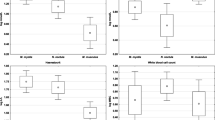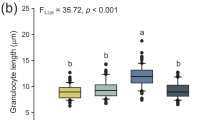Abstract
A functional connection between the pineal gland (via the hormone melatonin) and the immune system has been suggested. In our previous results in the ring dove, we observed diurnal oscillations in the levels of this neurohormone in young animals and a decline in its plasma levels with advancing age (which is accompanied by the absence of diurnal rhythm). We also noted enhanced phagocytic activity of heterophils from old animals after in vitro incubation with both physiological and pharmacological doses of melatonin. Here, we evaluate the functional capacity of ring dove (Streptopelia risoria) heterophils in young (2 years of age) and old (8 years and more) animals at different times of day (0:00, 10:00 and 16:00, the times when the maximum, minimum, and mean values, respectively, of melatonin levels are observed in young animals). The phagocytic capacities for the ingestion of latex beads and Candida albicans were evaluated, as well as the oxidative metabolism which accompanies phagocytosis. At all three times of day studied, the heterophil phagocytic function with both latex and C. albicans was significantly greater in the young than in the old animals, and in the young animal cells it was significantly higher at 0:00. In addition, in the presence of latex beads, there was a significant decline at 10:00 and 0:00 of superoxide anion levels in the young animals relative to the old. In the young animals, there was a decline at 0:00 in comparison with both 10:00 and 16:00, and in the old animals there was a decline at both 0:00 and 16:00 compared with 10:00. These results could be due, at least in part, to the absence of a diurnal rhythm of melatonin in old animals, and to an enhancing effect of that hormone on young animals’ heterophil phagocytic function, which would also neutralize the oxidative stress deriving from this immune function.



Similar content being viewed by others
Abbreviations
- PBS :
-
phosphate-buffered saline
- MIF :
-
macrophage migration-inhibition factor
- PI :
-
phagocytosis index
- PP :
-
phagocytosis percentage
- PE :
-
phagocytosis efficiency
References
Angeli A, Gatti G, Masera R, Sartori ML, Carignola R (1990) Chronobiological aspects of neuroendocrine-immune interactions. Int J Neurosci 51(3–4):341–343
Babior BM (1987) Oxygen-dependent microbial killing by phagocytes. N Engl J Med 298:659–666
Bagasra O, Howeedy A, Kajdacsy-Balla A (1988) Macrophage function in chronic experimental alcoholism. I. Modulation of surface receptors and phagocytosis. Immunology 65(3):405–409
Barriga C, Martin MI, Tabla R, Ortega E, Rodríguez AB (2001) Circadian rhythm of melatonin, corticosterone and phagocytosis hormones: effect of stress. J Pineal Res 30(3):180–187
Cardinali DP, Brusco LI, Selgas L, Esquifito AI (1998) Diurnal rhythms in ornithine decarboxylase activity and norepinephrine and acetylcholine synthesis in submaxillary lymph nodes and spleen of young and aged rats during Freund’s adjuvant-induced arthritis. Brain Res 13;789(2):283–292
Cardinali DP, Brusco LI, Cutrera A, Castrillon P, Esquifito AI (1999) Melatonin as a time-meaningful signal in circadian organization of immune response. Biol Signals Recept 8(1–2):41–48
Conti A, Maestroni GJM (1994) Melatonin-induced immuno-opioids: role in lymphoproliferative and autoimmune diseases. Adv Pineal Res 7:83–100
Curnette JT, Boxer LA (1985) Clinical significant phagocytic cell defect. In: Renington SS, Swhartz MU, (eds). Current topics in infectious diseases clinical. McGraw-Hill, New York, pp 103–155
Gallin JL (1989) Fundamental immunology. Raven Press, New York, pp 721–733
Hardeland R, Reiter RJ, Poeggeler B, Tan DX (1992) The significance of the metabolism of the neurohormone melatonin: antioxidative protection and formation of bioactive substance. Neurosci Biobehav Rev 17:347–357
Levi F, Cannon C, Depres-Brummer P, Adam R, Bourin P, Pati A, Flotentin I, Misset JL, Bismuth H (1992) The rhythmic organization of the immune network: implication for the chronopharmacologic delivery of interferons, interleukins and cyclosporin. Adv Drug Deliv Rev 9:85–112
Markowska M, Bialecka B, Ciechanowska M, Koter Z, Laskowska H, Karkucinska-Wieckowska A (2000) Effect of immunization on nocturnal NAT activity in chicken pineal gland. Neuroendocrinol Lett 21:367–373
McNulty JA, Relfson M, Fox LM, Fox LM, Kus L, Honda RJ, Scneider GB (1990) Circadian analysis of mononuclear cells in the rat following pinealectomy and superior cervical ganglionectomy. Brain Behav Immun 4(4):292–307
Park BH, Fikring SM, Smithwick EM, (1968) Infection and nitroblue reduction by neitrophils. A diagnostic aid. Lancet 532
Pierpaoli W, Maestroni GJM (1987) Melatonin: a principal neuroimmunoregulatory and anti-stress hormone: its anti-aging effects. Immunol Lett 16(3–4):355–362
Poeggeler B, Reiter RJ, Tan DX, Chen LD, Manchester LC (1990) Melatonin, hydroxyl radical-mediated oxidative damage and aging: a hypothesis. J Pineal Res 14:151
Reiter RJ (1995) The pineal gland and melatonin in relation to aging: a summary of the theories and the data. Exp Gerontol 30(3–4):199–212
Reiter RJ (1997) Antioxidant actions of melatonin. Adv Pharmacol 38:103–117
Reiter RJ, Tan DX, Qi W, Manchester LC, Karbownik M, Calvo JR (2000) Pharmacology and physiology of melatonin in the reduction of oxidative stress in vivo. Biol Signals Recept 9(3–4):160–171
Rodríguez AB, Lea RW (1994) Effect of pinealectomy upon the nonspecific immune response of the ring-dove (Streptopelia risoria). J Pineal Res 16(3):159–166
Rodríguez AB, Barriga C, De la Fuente M (1990) Phagocytic function and antibody-dependent cellular cytotoxicity of human neutrophils in the presence of N-formimidoylthienamycin. Agents Actions 31 (1–2):86–95
Rodríguez AB, Ortega E, Lea RW, Barriga C (1997) Melatonin and the phagocytic process of heterophils from ring dove (Streptopelia risoria). Mol Cell Biochem 168(1–2):185–190
Rodríguez AB, Nogales G, Ortega E, Barriga C (1998) Melatonin controls of superoxide anion level: modulation of superoxide dismutase activity in ring dove heterophils. J Pineal Res 24(1):9–14
Rodríguez AB, Marchena JM, Nogales G, Durán J, Barriga C (1999a) Correlation between the circadian rhythm of melatonin, phagocytosis and superoxide anion levels in ring dove heterophils. J Pineal Res 26(1):35–42
Rodríguez AB, Nogales G, Marchena JM, Barriga C (1999b) Suppression of both basal and antigen-induced lipid peroxidation in ring dove heterophils by melatonin. Biochem Pharmacol 15;58(8):1301–1306
Rodríguez AB, Terrón MP, Durán J, Ortega E, Barriga C (2001) Physiological concentrations of melatonin and corticosterone affect phagocytosis and oxidative metabolism of ring dove heterophils. J Pineal Res 31(1):31–38
Rosolowska-Huszcz D, Thaela MJ, Jagura M, Stepien D, Skwarlo-Sonta K (1991) Pineal influence on the diurnal rhythm of nonspecific immunity indices in chickens. J Pineal Res 10(4):190–195
Skwarlo-Sonta K, Thaela MJ, Gluchowska B, Stepien D, Jagura M (1991) Effect of dose and time of melatonin injections on the diurnal rhythm of immunity in chicken. J Pineal Res 10:30–35
Skwarlo-Sonta K, Thaela MJ, Midura M, Lech B, Gluchowska B, Drela N, Kozlowska E, Kowalczyk R (1992) Exogenous melatonin modifies the circadian rhythm but does not increase the level of some immune parameters in the chickens. J Pineal Res 12(1):37–34
Skwarlo-Sonta K (1996) Functional connections between the pineal gland immune system. Acta Neurobiol Exp 56(1):341–357
Skwarlo-Sonta K (2002) Melatonin in immunity: comparative aspects. Neuroendocrinol Lett 23(1):61–66
Tan DX, Chen LD, Poeggeler P, Manchester LC, Reiter RJ (1993) Melatonin: a potent, endogenous hydroxyl radical scavenger. Endocrine J 1:57–60
Terrón MP, Cubero J, Marchena JM, Barriga C, Rodríguez AB (2002) Melatonin and aging: in vitro effect of young and mature ring dove physiological concentrations of melatonin on the phagocytic function of heterophils from old ring dove. Exp Gerontol 37(2–3):421–426
Terrón MP, Cubero J, Barriga C, Ortega E, Rodríguez A.B (2003) Phagocytosis of Candida albicans and superoxide anion levels in ring dove (Streptopelia risoria) heterophils: effect of melatonin. J Neuroendocrinol 15(12):1111–1115
Turek FW, Zee P, Reeth VO (2000) Melatonin and aging. Melatonin after four decades. Kluwer, New York, 435
Acknowledgements
This investigation was supported by a research grant from the Spanish Ministry of Science and Technology (BFI2002-04583-C02-01). Research grants were awarded also to M.P. Terrón and S.D. Paredes by Consejeria de Educación Ciencia y Tecnología—Fondo Social Europeo (Junta de Extremadura, FIC00B013 and FIC02A049, respectively). The authors would like to express their thanks to Elena Circujano Vadillo for her technical assistance.
Author information
Authors and Affiliations
Corresponding author
Additional information
Communicated by G. Heldmaier
Rights and permissions
About this article
Cite this article
Terrón, M.P., Paredes, S.D., Barriga, C. et al. Comparative study of the heterophil phagocytic function in young and old ring doves (Streptopelia risoria) and its relationship with melatonin levels. J Comp Physiol B 174, 421–427 (2004). https://doi.org/10.1007/s00360-004-0429-1
Accepted:
Published:
Issue Date:
DOI: https://doi.org/10.1007/s00360-004-0429-1




